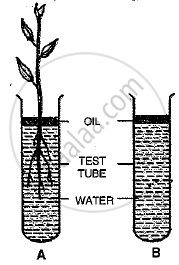Advertisements
Advertisements
प्रश्न
An experiment was set up as shown in the figure below. After some time, the Water level in test tube A fell down but not in test tube B.

Why was there a fall in the water level of test tube A and not in that of test-tube B?
उत्तर
Test tube A contains a plant, so the water level falls as the plant absorbs water through its roots, which are submerged in the water. Since there is a layer of oil in the test tube, water loss due to evaporation does not occur, as the oil prevents water molecules from evaporating.
In test tube B, the water level remains unchanged because there is no plant to absorb the water, and the oil layer also prevents any evaporation.
The difference in water levels between the two test tubes demonstrates water is absorbed by the plant through the roots dipped in the water, which leads to a fall in the water level in test tube A. In contrast, test tube B shows no change in water level without any plant.
APPEARS IN
संबंधित प्रश्न
Force responsible for the ascent of sap is:
How are roots useful to the plants? Give any two points.
State whether the following statement is true or false. Rewrite the false statement correctly.
Water absorbed by the roots reaches the leaves and is used in producing food for the entire plant.
Give two major functions of roots.
Name the following:
The process by which intact plants lose water in the form of droplets from leaf margins.
Name the following:
The tissue concerned with upward conduction of water in plants.
Name the following:
The pressure which is responsible for the movement of water molecules across the cortical cells of the root.
Mention whether the following statement is true (T) or false (F) and give an explanation in support of your answer.
Guttation is another name for bleeding in plants.
Root pressure can be measured by using ______.
